Archive for ‘Productivity’ Category
Organize Your Writing Time for NaNoWriMo 2022
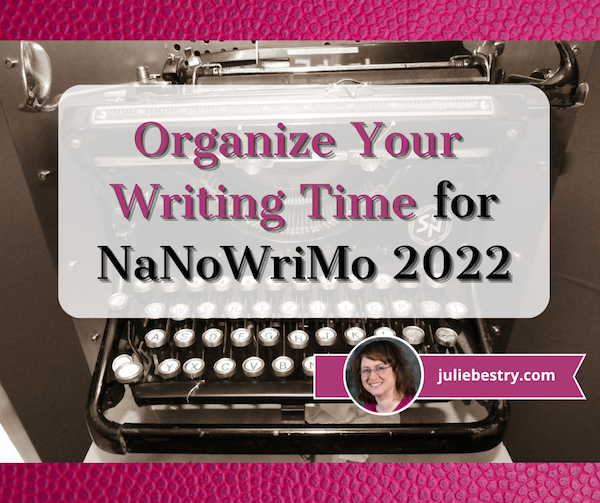
Have you ever imagined writing the Great American Novel?
Does the idea of getting revenge after the end of a turbulent relationship by (barely) disguising your ex as the villain (or victim) in a mystery appeal to you?
Maybe you’ve figured out exactly what Billy Joel was talking about when he sang that “Paul is a real estate novelist” and you’d like to be one too?
(If not, don’t skip out. There are treats here for anyone who wants to organize their time to achieve a goal.)
NaNoWriMo gives you the opportunity to follow your dream.
WHAT THE HECK IS NANOWRIMO?
In the weeks leading up to Halloween, and then all throughout the month of November, you may see #NaNoWriMo pop up in your social media feeds. NaNoWriMo is National Novel Writing Month.
If you’ve ever done a month-long challenge (plank or do yoga every day of January, keep a journal for mindfulness, give up Facebook for a month, etc.), you’ll be familiar with this kind of effort. Except, at the end, instead of a fit core, increased self-awareness, or the calm of not knowing that people with whom you went to high school are bringing about the downfall of civilization, you’ll have written a book!
Each year, NaNoWriMo participants commit to writing a 50,000-word novel between November 1st and 30th of the month. That amounts to an average of 1667 words per day, but it’s only the final count that matters. (Because nobody actually writes on Thanksgiving Day. Too many carbs.)
Sign up on the website, maybe join some supportive forums, and then start writing. You can log your daily count and even get cute little badges for your progress.
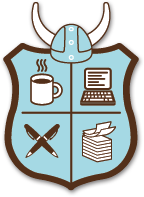
Officially, there are opportunities to prep your novel during September and October, and get guidance for developing a story idea, creating complex characters, constructing a detailed plot outline (because outlines, like maps, get you where you want to go), and building your story’s world.
All of these tasks are popular with plotters (people who create detailed outlines and prepare for the NaNoWriMo experience). Of course, there are also pantsers, authors who prefer to write by the seats of their pants and plan very little.
On a related note, there are also rebelsm with or without a cause. Although it’s designed as National Novel Writing Month, nobody is going to kick you out of the clubhouse for writing your dissertation, a graphic novel, your memoir, or whatever else you feel called to write. You may have noticed that I write really long blog posts — some topping 3000 words! One year, I used November to write most of a dozen blog posts and several articles.
It’s not cheating, it’s rebelling. (Doesn’t that sound a lot cooler? You can just imagine the leather jacket and the motorcycle.)
At any point, you can upload your novel to the NaNoWriMo website and it will verify your word count. When — let’s be confident! “if” is so iffy! — you hit that 50,000 word count, you can say that you’ve “won” NaNoWriMo for the year.
Winners get a certificate and a banner for display on social media accounts or any other web real estate, and you can purchase a T-shirt and other merchandise in the site’s store. Whether you actually publish or not — even if you never show your novel to anyone else — you’ll still know that you took on a challenge (one that didn’t involve surviving a global plague or not strangling any relatives at the Thanksgiving table) and triumphed.
GET BY WITH A LITTLE HELP FROM YOUR NANOWRIMO FRIENDS
Paper Doll readers know that I am all about mutual support, collaboration, and accountability, and so is NaNoWriMo. Throughout November (and actually, all year), you can avail yourself of a variety of writing assistance and support:
- Discussion Forums — for covering everything from navigating genres to developing storylines to filling plot holes and punching up dialogue
- Writing Groups — for writers seeking camaraderie with people of specific geographical regions, writing styles, or needs. There’s a group for writers with ADHD, authors who write fanfiction, and one called “Rom-Com Writers with Procrastination.”
- Regional Support — from as wide a swath as the whole of Africa to as narrow as a neighborhood near you, you can find people to share your journey
- Writing Buddies — NaNoWriMo makes it easy to find writing partners with whom you can trade ideas (or tales of woe)
As a Paper Doll reader, you already know the importance of accountability, but these two posts may also suit you well on your NaNoWriMo path.
- Count On Accountability: 5 Productivity Support Solutions
- Flow and Faux (Accountability): Productivity, Focus, and Alex Trebek
NaNoWriMo are offers both new and archived Pep Talks from professional writers. I mean, if Outlander author Diana Gabaldon, Alex Cross mystery creator James Patterson, young adult novelist John Green, and MacArthur Genius-winning sci-fi writer N.K. Jemison can’t inspire you to write, who can?
If you need more motivation, NaNoWriMo sponsors offer some amazing prizes for both participants and “winners” who meet the 50,000 word goal. These include discounts for writing software (including Scrivener, Pro Writing Aid, NovelPad, and Plottr), digital devices, and writing/publishing support, and more.
So, you’ve decided you’re going to do this. You register, you post a banner and share your goal on social media, and now you’re watching the clock tick down to November. Now what?
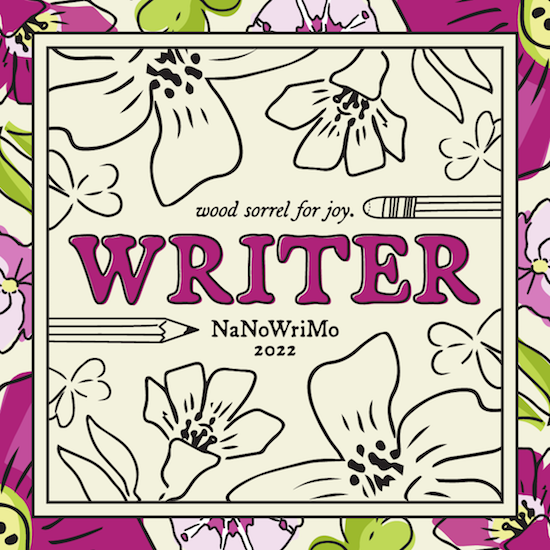
ORGANIZE YOUR WRITING TIME
Last week, I was approached by someone who wanted advice on carving out time to write while still working a full-time job. I was honest; there’s no way to have more than 24 hours in the day, and contrary to what gets thrown around on social media, we do not all have the same 24 hours.
If you’ve got a full-time job (or multiple part-time ones), are raising kids, have a chronic illness, are caring for one more senior parents, or some combination of any of the above, you’re going to have less disposable time (like a temporal disposable income) than a single, healthy twenty-something. Time is not going to freeze and make time for you to write. So, consider stacking a few of these options to achieve your writing goals.
Accept that you have to dedicate specific chunks of time to writing.
You may be a pantser, but that’s about figuring out what you’re going to write. There’s no way to achieve any writing goal, whether writing a novel or finishing a term paper, without deciding when you’re going to write.
If you’re the kind of person who has to feel motivation to do something, I’ve got news for you:
Action precedes motivation.
You have to do something before you’re ready. Your 50K-word novel doesn’t have to be perfect; it doesn’t have to be polished. It doesn’t even have to be good. Your November writing project can be a hot mess!
But here’s my favorite truth about writing. You can’t edit a blank page.
Your 50K word novel doesn't have to be perfect; it doesn't have to be polished. It doesn't even have to be good. Your writing project can be a hot mess! But here's my favorite truth about writing. You can't edit a blank page. Share on XSo feel free to write whenever you feel inspired. Nobody’s going to stop you from grabbing your notepad or keyboard or a quill pen (except, maybe the bird from which the feather was plucked). But schedule time to ensure that you have dependable time to write.
The same is true of organizing or anything else you do. Nobody will arrest you for jumping up during a commercial break in Grey’s Anatomy to load the dishwasher. But if you consider dinner tasks to include meal planning, cooking, clearing the table, and loading the dishwasher, and that “dinner isn’t finished until the dishes are done,” then you won’t ever have to dread walking into the kitchen.
Know what you’re going to write.
Even if you’re pantser and don’t know (or want to know) what you’re going to be writing on November 17th, let the back of your brain ruminate while you’re doing mindless tasks like bushing your teeth to get a sense of what you’ll be working on in your next writing session.
If you don’t know what you’re going to write, you will avoid sitting down to write. If you procrastinate and avoiding writing…you will not have written! Sad but true.
And if you do manage to sit down to write with no idea what you’re going to write about, you’ll get distracted. You do not want to get distracted, or you’ll end up with something like this:
Good, great, excellent pic.twitter.com/415p8iwDGH
— Writers’ HQ (@writers_hq) July 13, 2022
If you can’t stand the idea of knowing what you’re going to write ahead of time because you feel like that would mess with the mojo of your creative muse, there’s an alternative to an outline.
Grab a stack of index cards and write down key words or concepts: character’s names, key plot elements, essential conversational high points. Then stuff the carnds in a jar or a hat, and when you sit down to write, grab a card to use as a writing prompt. Yes, you’ll be writing out of order and will have a harder job later on, cutting and pasting, but you’ll be writing!
Block your time…and put some blocks on ice.
Start with my post Playing With Blocks: Success Strategies for Time Blocking Productivity to re-familiarize yourself again time blocking.
Look at your schedule (and if you don’t have one, pull out a paper or digital calendar and hour-by-hour, day-by-day) and write down everything that’s already an obligation. That may be work, school, childcare, other-care, scheduled self-care and personal growth (like yoga or practicing a language or instrument).
What do you use, a to-do list or a schedule? pic.twitter.com/UEG2dH1ES0
— Sarah Arnold-Hall (@saraharnoldhall) September 28, 2022
Then write down all the things you do that aren’t ever scheduled, but which you have to do, from sleeping to grooming to housework and grocery shopping.
Identify blank spaces — if you have any. Those are your first options for writing time. If you’ve got blank space, you might be able to use it to write. (I say “might” because nobody can have all their waking time occupied. We need time to veg out, as I discussed in Toxic Productivity Part 2: How to Change Your Mindset. We can’t create without downtime.)
What if you don’t have any blank spaces? Consider whether you can remove some responsibilities for the duration of November. It’s about priorities. (This is true no matter what life goals you are trying to reach.)
- Can you do one big grocery shop for the month and delegate the urgent milk-and-bread runs to another member of the household? (Or delegate all November grocery shopping and housework to someone whom you support in all of their goal achievement practices?)
- Hire a babysitter for a handful of hours each week?
- Are you willing to get up 45 minutes earlier, or stay up an hour later to get some writing time?
- Can you cut out scrolling through TikTok of your November (or limit it to when you’re standing in line at the store or hanging out anyplace where that you couldn’t otherwise sit down and write)?
- And, as a former broadcasting professional, I can’t believe I’m suggesting this, but could you cut an hour of TV viewing out of your life?
When it comes down to it, there some things you have to do in November: eat, sleep, hydrate, groom, work for pay, take care of dependent humans, and vote. (Please, please remember to vote!) But for 30 days, can you vacuum less? Binge fewer shows?)
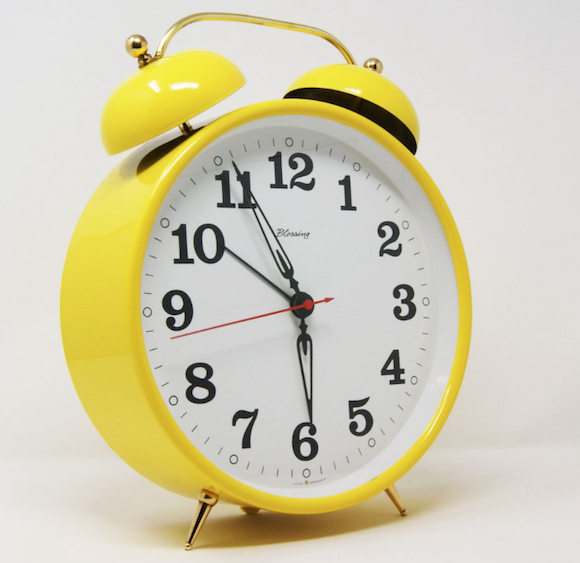
What if you have blank spaces, but they’re short or weird? It’s possible you have lots of writing opportunities, but none are expansive chunks of ninety minutes or two hours. That’s OK. If you have a good outline (that’s where being a plotter has the advantage over being a pantser), you don’t need long blocks of time.
If you have 15 minutes between when you get home from work and everyone else gets home, focus on just one small part of your outline. Are you stuck on the dialogue for a scene for a pivotal conversation between two characters? Play-act the conversation while you’re in the shower or while driving; it’ll help you get the language and tone right; when you’re getting close to how it should sound (and are out of the shower), use the voice memo on your phone or dictate it into a text to yourself to capture the wording. You can transcribe or copy it into your manuscript later.
Rejoice in exploring short writing blocks. It’s less time to dither or second-guess your writing. Focus on getting words on paper. Consider having 25 minutes (one whole glorious pomodoro) the perfect amount of time to work on two or three great paragraphs.
Can you get up 15 minutes earlier and skip 10 minutes of Twitter scrolling to get those 25 minutes? There’s one writing block.
Can you bring your lunch to work so that you use half your lunch hour for eating and relaxing and the other half for writing?
Can you convince your significant other to take over an evening task like laundry, just for November, to give you 25 minutes every evening?
Boom! There’s your writing time!
Let NaNoWriMo figure out your best writing schedule.
NaNoWriMo has a cute social media-style quiz for figuring out the best schedule for your personality and lifestyle. It’ll only take about thirty seconds, and may yield some insight.
Guard your writing time.
Several ago, I wrote R-E-S-P-E-C-T: The Organizing Secret for Working At Home, and many of the concepts apply to helping others in your space respect your time and boundaries. But there are also tips for respecting your own time, staying focused and on-task, and not letting other’s non-emegencies squeeze your time.
Consider what motivates you.
Obviously, you shouldn’t do NaNoWriMo if it doesn’t appeal to you. But before the month even gets started, make a list of all the reasons why you want to do it.
Whether it’s to get back at your 11th-grade English teacher who was dismissive of your creative efforts or to give you confidence that you can step out of your comfort zone, come up with ten big and small reasons you are inspired to write a 50,000 word draft of a novel.
Then write ten more reasons. And ten more after that!
Read one of those reasons aloud at the start of every day in November. Give yourself a fighting chance to overcome inertia and achieve your goal!
Currently stuck in nocturnal. Where are you? pic.twitter.com/9ppvAultN0
— Writers’ HQ (@writers_hq) January 31, 2020
Track Your Progress
Every time I write about NaNoWriMo, I like to share David Seah’s Word Counting Calendar. Print out the black-and-white or color versions. Every day that you write, just log your total word count and then color in the appropriate boxes.
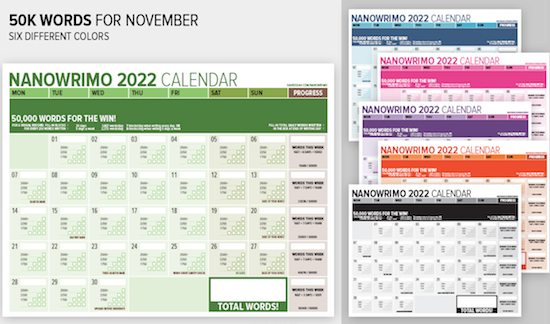
Post the calendar near your writing space to keep you motivated as you progress toward your goal.
EMBRACE THESE RESOURCES
You could write a book (or several) about all the resources available for supporting a writing project. Here are just a few classics and new-for-2022 to help you organize your thoughts, your research, your writing, and your November.

10 Steps to Get Started with Scrivener for NaNoWriMo — Updated for 2022, this list from the ultimate writer’s tool walks you through how to make the software serve your NaNo needs.
Your Essential Guide to Completing NaNoWriMo in Evernote — As an Evernote Expert, I’m constantly finding (and sharing) new ways to use Evernote to support work and personal goals. Anthony Bartlett has gathered some great advice, including linking to essential Evernote templates for creating character profiles, plotting your novel, story premises, and 3-act structures.
12 Creative Writing Templates for Planning Your Novel — Speaking of templates, Forrest Dylan Bryant walks you through a dozen templates, from those listed above to writing trackers to plot and character templates. Don’t reinvent the wheel when you can use Evernote templates to support your writing and story development.
A Novel Strategy: How to Organize Big Writing Projects — Speaking of Forrest, about five years ago, he wrote this nifty post about how to use Evernote to organize your notes for writing a novel.
(P.S. Combining all of the info above, if you’re thinking of using Scrivener, know that you can import your Evernote notes into Scrivener and see your notes and writing area side-by-side. Cool beans!)
What is NaNoWriMo? And How to Win in 2022 — Updated every year, this masterful post from Reedsy has dozens of tips for managing your time, developing your writing ear, and keeping up your motivation.
Write a 50,000-Word Pulp Novel Before Breakfast: My easy no-outline way of writing short novels in four weeks by Amethyst Qu
How to Survive NaNoWriMo in 2022: 17 Top Tips for Success — Self-Publishing School offers a list of winning habits to help make the most of your November.
Although I don’t write about NaNoWriMo every year, there are several posts in the vault, including those from 2017, where I created NaNoWriMoMo and wrote advice for organizing yourself for NaNoWriMo every single Monday of that November. Just type “NaNoWriMo” into the search sidebar on the left of this site to find them.
Whatever you choose to do with the coming month, I hope you take time to plan and organize to help your dreams come true.
Paper Doll Responds When They Say “Be Our Guest”
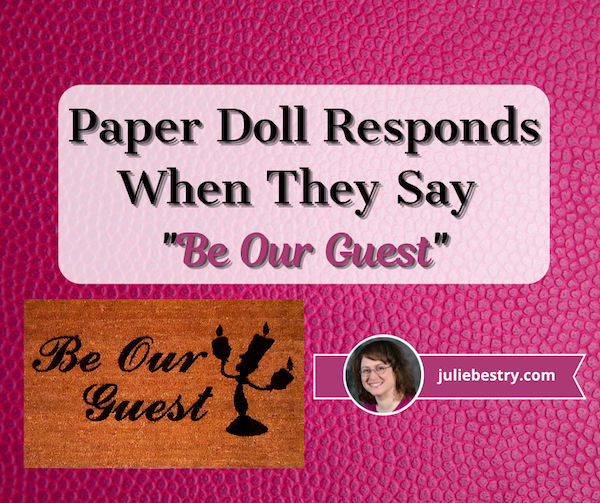
The theme of this week’s post has become somewhat bittersweet since the I originally conceived it. On Tuesday, October 11, 2022, Dame Angela Lansbury passed away at the age of 96. Depending on your age and tastes, you may know Lansbury from various points in her eighty-year career.
If you’re a cinephile, you may know her from films from her earliest role in Gaslight and in the 1940s to The Manchurian Candidate in the 1960s and Bedknobs and Broomsticks in the 1970s, to Anastasia, Mary Poppins Returns and the Knives Out sequel, which hasn’t even been released yet!
If you’re a fan of Broadway, you could have caught her in anything from Stephen Sondheim’s early Anyone Can Whistle to the title role in Auntie Mame to the distasteful pie-baking Mrs. Lovett in Sweeney Todd: The Demon Barber of Fleet Street. And, if you watched television in the 1980s, 1990s, or 2000s, then you probably knew her best as Jessica Fletcher from Murder, She Wrote.
However, if you’ve been a kid or a parent or a baby sitter any time since 1991, then you will recall Lansbury voicing Mrs. Potts (alongside Jerry Orbach’s Lumière) in the classic animated Disney production of Beauty and the Beast. And if you’re wondering what any of this has to do with organizing, here’s a hint:
Perhaps this post’s theme might seem less shoehorned in (if less palatable) if I could sing it to you. But recently, I was asked to serve as a guest and offer advice and information on three disparate topics: productivity, technology, and paper, and I’d like the opportunity to share this material with you.
THE CHATTANOOGA TIMES FREE PRESS EDGE MAGAZINE
On October 20, 2002, almost twenty years ago, in Professional Organizers Are A Growing Trend, I was profiled in the Chattanooga Times Free Press for the first time. Over the years, I’ve been delighted to be interviewed, right up through March 2021, when I was profiled in the newspaper’s Edge, a business-themed magazine.
However, I was particularly giddy when Jennifer McNally, the new editor of Edge asked me to write the October Business Acumen column in an issue devoted to staying productive. While the issue is geared toward professionals and business owners in the Chattanooga region, I think you’ll find it informative and appealing, no matter where you reside or what you do.
You can read the entire October issue of the Edge — my column spans pages 24 and 25, but other columns range from How to Own Failure (and Still Preserve Your Reputation) to the Take It From the Top series with advice from Chattanooga leaders on issues ranging from tracking goals, focus, and discipline to allocating time strategically and anticipating challenges.
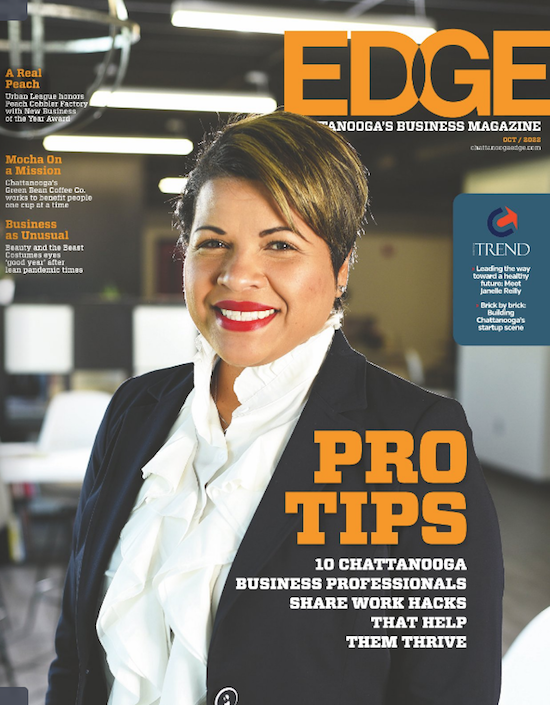
You can also head directly to my guest Business Acumen column, An Expert’s Secrets to Stress-Free Productivity on the newspaper’s site. To give you a taste, it starts with:
Do you feel like life is more demanding than ever, and that effective productivity is hard to achieve? Workdays (and too often, nights) are packed with back-to-back meetings and Zoom calls, Slack notifications and email alerts. Productivity can be elusive.
Maybe you feel like you’re doing more but accomplishing less that rewards you. Increasingly, we’re seeing toxic productivity, where pressure to meet unrealistic expectations zaps physical and mental energy, damaging motivation and self-esteem. But it doesn’t have to be this way.
In the column, I share my strategies for conquering overwhelm by identifying your priorities, protecting your focus, creating flow, and conquering procrastination. I encourage you to take a peek and let me know what you think.
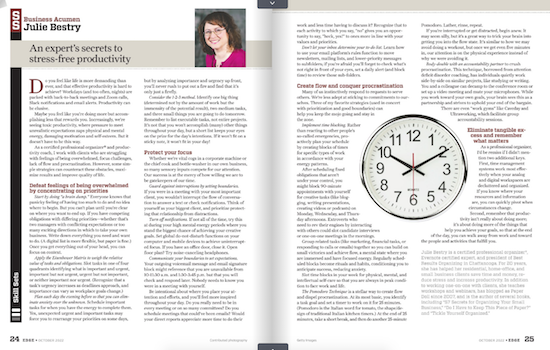
THE STREAMLINED CONNECTION
A particularly charming guest experience was getting to be on my friend and colleague Miriam Ortiz Y Pino‘s video podcast, The Streamlined Connection.
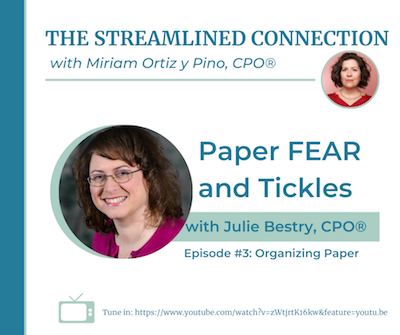
Miriam is a Certified Professional Organizer and Money Breakthrough Business Coach. Her company is More Than Organized, and she’s a firecracker! Like me, she’s been at this for more than two decades, and Miriam’s got an amazing way of creating transformation.
Miriam offers one-on-one in-person and virtual services including organizing, business coaching, speaking, and training in a variety of areas (including the fascinating topic of Sacred Money Archetypes). Miriam also delivers Streamlined Solutions courses for tackling clutter, time troubles, and paper, and live and virtual group workshops for professionals.
It’s an absolute trip to talk to Miriam, because every conversation yields insight. So, I was tickled to be the first guest on her show.
As a Paper Doll reader, you will not be surprised that, when given the opportunity to talk about organizing, I chose my favorite topic, paper. However, unlike when I talked about the philosophical aspects of Why Paper Still Matters on the NAPO podcast earlier this summer, Miriam and I went in a different direction.
On Organizing Paper with Julie Bestry: Paper FEAR and Tickles, we explored the nitty gritty of the frustrations of different types of paper clutter, and how strategically considering both fear and tickles can help you dig out from under.
Miriam has since had some organizing and productivity industry rock stars as guests, including Amy Payne, Regina Lark, Geralin Thomas, Mike Vardy, Leslie Josel, Robyn Reynolds, and Nietra Rose! (Seriously, check it out!)
ORGANIZED ASSISTANT
The amazing (and Canadian) Janet Barclay has graced Paper Doll‘s pages many times over the years. I’ve known Janet since the days before modern social media, when we were both getting the hang of things on Ryze.com. (Don’t go visit; it’s all spam now. Sigh.)
Although Janet started out as a professional organizer and productivity consultant, she eventually found and perfected her niche in supporting organizing professionals. She works her magic as a “website caregiver and designer,” which means she helps people keep their online identities afloat so we can focus on our own clients. She rocks that way.
But Janet rocks another way, as one of the biggest cheerleaders of the organizing and productivity profession. Her Organized Assistant web site is home to blog posts and articles that provide a broad perspective for those of us who work in the field, but she also created the Productivity and Organizing Blog Carnival for the reading public, collecting monthly themed posts on categories ranging from organizing junk drawers to efficiency in the workplace to organizing when a member of the family is ill.
I’m proud to say that I’m one of Janet’s Megastar Blogggers, having contributed to more than 50 monthly carnivals, and am joined by my fancy-pants colleagues Hazel Thornton, Linda Samuels, Sabrina Quairoli, and Seana Turner.
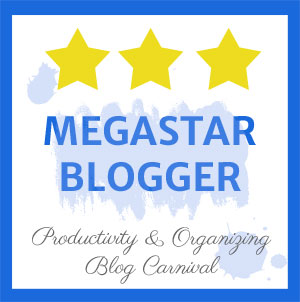 In the spring, I referenced having recertified as an Evernote Certified Expert. As I often talk about the reasons I love and use Evernote, Janet asked if I’d like to share the certification process with her readers, and I was only too excited to do so.
In the spring, I referenced having recertified as an Evernote Certified Expert. As I often talk about the reasons I love and use Evernote, Janet asked if I’d like to share the certification process with her readers, and I was only too excited to do so.
As an Evernote user, it was easy to pull together my resources for the guest post. I had notes from my original certification as an Evernote Certified Business Consultant in 2015, then as an Evernote Certified Consultant a few years later, and now under the current program, an Evernote Certified Expert. Evernote’s so-powerful-it’s-spooky search capacity found everything I needed to write Adventures in Becoming an Evernote Certified Expert. (This also means I had no excuse for procrastinating on actually writing it!)
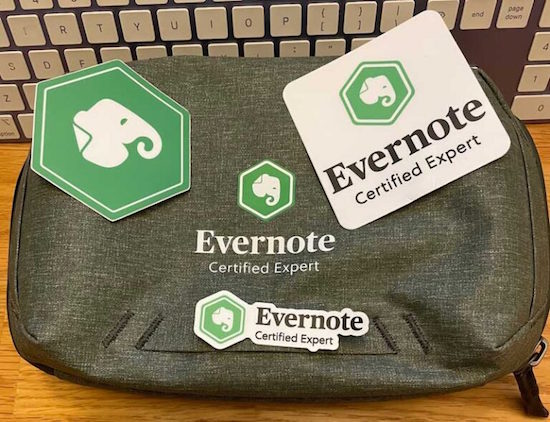
Hopefully, you’ll be entertained as you learn about my experience getting certified, and it may encourage you to get certified, use the skills and support of an Evernote Certified Expert, or just learn more about Evernote in its newest incarnation as so much more than just a note-taking app.
Writing this, I’m shocked to realize it’s been nine years since I’ve written an entire post about Evernote. It’s a completely different platform now, with so many more features and opportunities to organize your digital life. So, don’t be surprised to see more Paper Doll posts in the future regarding how you can use Evernote to be more organized and productive.
BE YOUR GUEST?
As much as I love working with my in-person and virtual clients, giving presentations, and writing this blog, it’s even more fun when I get to share a (digital) stage or blog space. As I’ve reported, throughout 2022 I’ve been on a variety of podcasts and have guested at various summits, about which you can read more:
Paper Doll on the NAPO Stand Out Podcast: Why Paper Still Matters
Paper Doll Picks: Organizing and Productivity Podcasts
Paper Doll on Planning & Prioritizing for Leadership
Paper Doll Shares Secrets from the Task Management & Time Blocking Summit 2022
Not enough Paper Doll for you? You can also check out my Press Room page for more links to interviews and guest spots.
If you have a podcast, summit, or blog for which you might like to interview me on topics related to paper and information organizing or productivity, please feel free to use the Contact page on my site to let me know how we might work together.
ONE LAST LOOK AT MRS. POTTS & LUMIÈRE
Paper Doll cannot live by organizing alone, and I hope that as my guests, you take some delight in the pop culture cameos that have populated this blog since 2007.
Whether solving crimes as Jessica Fletcher or making the worst pies in London as Mrs. Lovett, or getting nominated for Academy Awards, Tony Awards, Golden Globes, or Emmy or Grammy Awards, Angela Lansbury was beloved. And as Lumière to her Mrs. Potts, Jerry Orbach (Law & Order‘s Lennie Briscoe, Baby’s father in Dirty Dancing, and in oodles of other roles on stage and screen) was no slouch, either. With that, I’d like to close today’s post with this behind-the-scenes view of how they put together “Be Our Guest.”
Thank you for being my guest at the Paper Doll blog, and thank you for letting me be a guest on your computer and mobile devices all these years.
Paper Doll Helps You Get By With a Little Help From Her (Brilliant) Friends
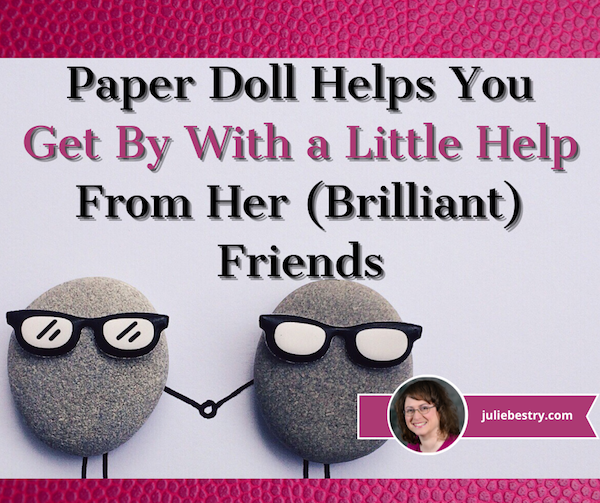
I love sharing my expertise and research with you about a wide variety of topics, from getting more (of the right things) done to conquering toxic productivity to accessing and organizing vital documents.
Although I’m a generalist in my professional organizing practice, I specialize in blogging about organizing paper and information and boosting productivity. But that doesn’t mean that’s all you want to hear about. After all, man (and woman) cannot live by bread alone. We also need cheese. (In Paper Doll‘s case, lots and lots of cheese.)
As a Certified Professional Organizer®, member of NAPO, and Evernote Certified Expert, I get to hobnob with other likeminded specialists, learn from them, and share their knowledge with you. Today, I’ve got a cornucopia of resources for making your life, family, and world run a little more smoothly.
LATE, LOST & LAGGING: UNDERSTANDING ADHD & EXECUTIVE FUNCTIONING
October is ADHD Awareness Month.
As recently as a few decades ago, people lacked a clear understanding of ADHD. If they thought about it at all, they considered it as something that only impacted little boys, that it was about being rambunctious and intentionally (or rebelliously) inattentive, and that it was something people grew out of. It was rarely acknowledged as something that impacted women and girls, and most people, if they considered it at all, thought it was something kids grew out of.
Now, we know more. We know that ADHD is a brain-based disorder, a neurological condition that affects people across all ages, genders, and socio-economic and cultural areas. (It’s diagnosed two-to-three times more often in boys than girls, but that may be because the expression of ADHD in girls can be less disruptive, which says more about socialization norms and pressures than it does about ADHD.)
ADHD impacts the lives people across all levels of education and intelligence. Willful ignorance about ADHD expresses itself in all levels of education and intelligence, as well.
I once worked with a client for whom her late-in-life diagnosed ADHD had caused distress throughout her life, and the emotional abuse inflicted on her by her physician spouse, who refused to “believe” in ADHD, was both eye-opening and frustrating as we tried to implement solutions. (Yes, Dr. Shouty-Dude, ADHD is real, and no, you can’t “conquer” it by having more “diligence” and “willpower.” Grrrr.)
If you or someone you know has ADHD or other challenges with executive functioning, ADHD Awareness Month is a great opportunity to learn more, and I’ve got a great webinar resource for you.
My NAPO colleague, ADHD Student Coach Leslie Josel of Order Out of Chaos, is one of my absolute go-to experts when I have a question about ADHD and executive function.

If Leslie’s name sounds familiar (and it should), it may be from the post Paper Doll Peeks Behind the Curtain with Superstar Coach, Author & Speaker Leslie Josel, where we talked about her multi-award-winning Academic Planner: A Tool for Time Management, which is celebrating its tenth anniversary,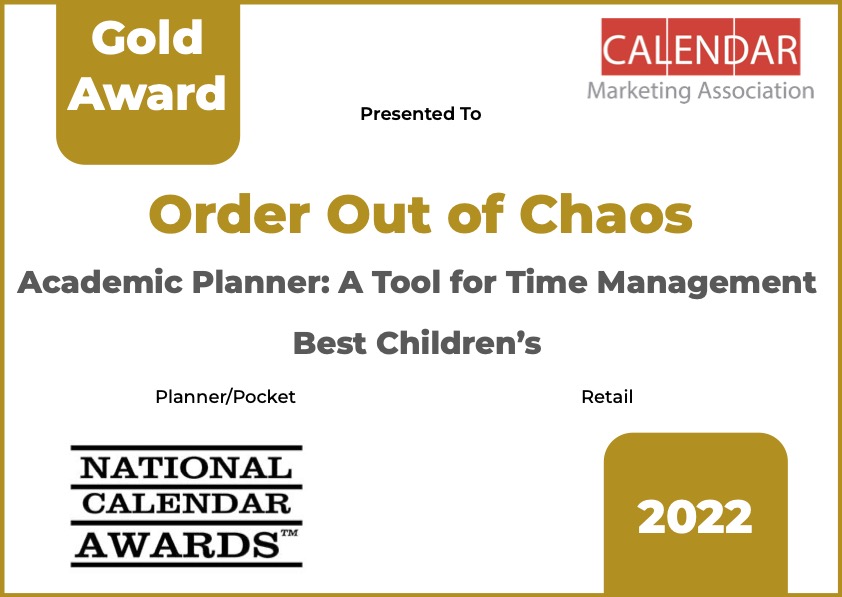
and her book, How to Do It Now Because It’s Not Going Away: An Expert Guide to Getting Stuff Done, which helps middle school, high school, and college students overcome academic procrastination and better manage manage time and study skills.
Organizing A Fresh Start: Catalysts for Success
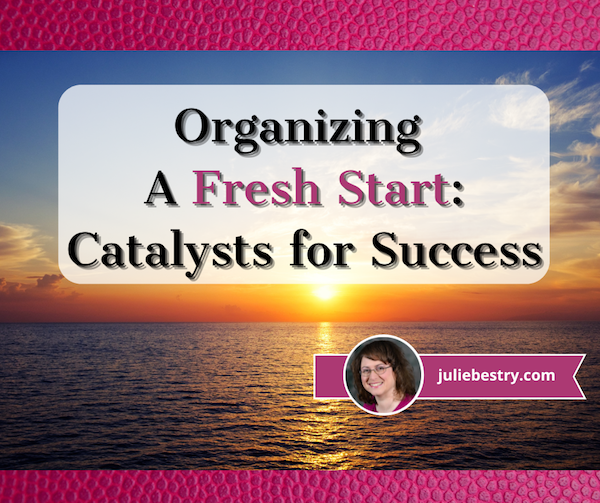
[Editor’s note: This post originally appeared on September 26, 2022. Rosh Hashanah will not be until October 2 in 2024, and changes each year, as the holiday is dependent upon a lunar calendar. The remainder of the content of this post is still accurate.]
As I go to press on this post, it’s about to be Rosh Hashanah, the Jewish New Year. (We’re going into the year 5783, though as the old joke goes, I’ll be writing 5782 on my checks for weeks.)
What I always liked about the idea of the Jewish New Year was the opportunity for a fresh start. Sure, in Western culture, we already have one (in either August or September, depending on your part of the country) with the beginning of a new school year. That always brings new clothes (and the jettisoning of old ones), new school supplies (especially brand new crayons and notebooks), and new opportunities.

Apples & Honey photo by Igal Ness on Unsplash
One of those opportunities, especially as we all got older (moving from elementary school to middle school, or middle school to high school) was that we could create ourselves anew, be seen as a different kind of person.
Let’s say you’d had a reputation as a goody two-shoes; you could make yourself over as a bit of a rebel. A ne’er-do-well punk could become an athlete lettering in varsity track. An academic washout could study a trade, and a beauty school dropout could rejoin the old gang. (Any resemblance to the plot of Grease is purely coincidental.)
But if you found yourself slipping back into old habits (messy lockers, messy friendships, messy study habits), the clean slate of a new year in the guise of a millennia-old religious and cultural tradition sure could be appealing. And if the start of the school year didn’t keep you on the straight-and-narrow toward a more perfect version of you? Well, Rosh Hashanah offered another shot.
And if that didn’t work, well, the new calendar year was only another 90 days or so away.
FRESH STARTS FOR THE NEW YEAR(S)
The best known annual fresh start is January 1st; worldwide, people explore New Year’s resolutions, to various degrees of success. Indeed, because of the difficulty of maintaining adherence to wholesale changes in one’s self, I often encourage alternatives to resolution making, like having goals, themes, phrases, or words of the year, such as those I wrote about in:
Review & Renew for 2022: Resolutions, Goals, and Words of the Year
Organize Your Life: The Truth About Resolutions, Goals, Habits, and Words of the Year
That said, some people still hold to the idea of making big changes when there’s a marker on the calendar to do so. If that’s you, I recommend reading what my colleagues and I have had to say at:
Join The Resolution Revolution
New Year’s Resolutions: Professional Organizers Blog Carnival
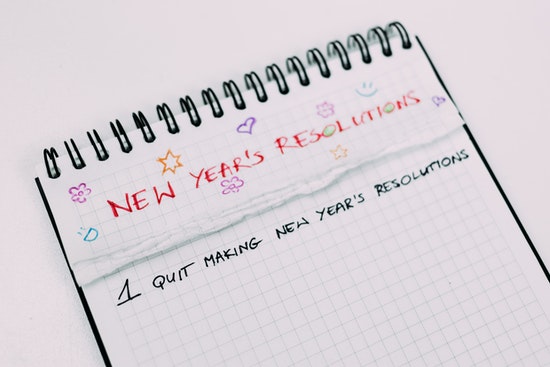
And, of course, your annual fresh starts aren’t limited to the new calendar year, new school year, or Rosh Hashanah. Worldwide, particularly in East and Southeast Asian nations and cultures, there are numerous religious and cultural new year’s observations, and you could choose any of those to give yourself a burst of inspiration.
Because lunar calendars (similar to the ones that make the Jewish holidays like Rosh Hashanah and Hanukkah bounce around the Gregorian calendar) are measured differently from what we use, these holidays don’t sync up to January first, nor do they fall on the same Gregorian calendar date each year.

These include:
- Chinese New Year — between late January and mid-February
- Lunar New Year (in Vietnam and other Southeast Asian nations) — between late January and mid-February
- Seollal (Korean New Year) — January or February, on the second new moon after the winter solstice
- Tết Nguyên Đán/Spring Festival/Lunar New Year/Vietnamese Lunar New Year — late January to mid-February
- Nyepi (Balinese New Year) — March
- Nowruz (Persian/Iranian New Year) — between March 19th and 22nd
- Aluth Avurudda (Sinhalese New Year) — April 13th or 14th
- Puthandu (Tamil New Year) — follows the spring equinox and generally falls on April 14th
- Willkakuti (Andean and Amazonian New Year) — June 21st
- Mayan Aboriginal New Year — mid-July
- Diwali (Marwari and Gujarati New Year Day) — mid-October to mid-November
- Raʼs as-Sanah al-Hijrīyah (Islamic New Year) — early July to late August
- Australian Aboriginal Murador New Year
As you can see, there are year-round “New Year’s” observations, if you’re looking to get a bit of institutional support for your new beginnings.
The meanings behind these holidays are as varied as the cultures from which they derive. Some focus on joy and celebration, others on introspection and focused self-improvement. The point is not to suggest that you necessarily observe religious or cultural New Year’s holidays or festivals, and certainly nobody should indulge in cultural appropriation.
Rather, consider these as inspirational opportunities to forgive yourself for any backsliding, identify ways you can tweak your efforts, and give yourself a motivational pep-talk.
FRESH STARTS EVERY QUARTER
If you work in the corporate world, you’re probably used to buzzwords about splitting the year into quarters. “Let’s ramp this up in 2Q!” or “We’re looking at projections for fourth quarter.” The year is carved into four 12/13ish week quarters with new collaborative goals structured into that temporal space.
Indeed, Brian Moran’s best-selling book and website, The 12-Week Year, is focused on the idea of setting shorter-term goals quarterly instead of annually. Rather than trying to transform yourself in a binary way, from “not this” yesterday to “this” today, this program posits that there’s an advantage to carving the year up into shorter 3-month blocks vs. trying to make changes on an annual basis.
Toxic Productivity Part 5: Technology and a Hungry Ghost

THE MANY TENDRILS OF TOXIC PRODUCTIVITY
I checked in with a friend the other day to see how her new job was going. Her company, an international conglomerate, had laid off several people over the past six months, including my friend, but also did some internal hiring. She’d been excited about getting the new job, but seemed blue when we spoke.
“I’ll be honest,” she told me, “if I hadn’t already worked for this company for years, I’d think I was incompetent. This is really hard.” My friend, a veteran of many, many promotions for merit, is definitely not incompetent. It turns out that only one person had ever held this position before, and was fired after being unable to keep up with the demands.
When I hear these stories from my clients, the first thing I do is get a sense of whether the problem is that someone needs more support or guidance at work. In terms of support, even though she’s at the same company, my friend’s work situation is different, and she’s no longer got the support of a team structure; rather, everyone is on his or her own, with no cross-training and no backup. The company still seems to have unreasonable expectations of how much can be humanly accomplished, as we discussed at the start of this series, in Toxic Productivity In the Workplace and What Comes Next.
Next, she and I talked about the Pareto Principle (AKA: the 80/20 Rule, which we discussed last week in Toxic Productivity, Part 4: Find the Flip Side of Productivity Hacks) and I asked my friend if she’d talked with her boss about priorities, and what the most important aspects of the job needed to be right now.
Remember, 80% of the success comes from 20% of the effort, so finding that 20% can eliminate a lot of the stress and busy-work, creating more mental energy to tackle other aspects of the work.
The Pareto Principle says 80% of the success comes from 20% of the effort, so finding that 20% can eliminate a lot of the stress and busy-work, creating more mental energy to tackle other aspects of the work. Share on XI pointed out that, as a valued employee, and as the second person to try to tackle this role, she might be in a position to (gently) point out these unreasonable expectations. (Yes, this is a touchy issue, but it’s the best way to determine if the problem is bad management practices or merely lack of corporate awareness of how many human-hours it takes to accomplish certain tasks.)
My friend then noted that a colleague of hers, another “island” unto himself in a position similar to herss, has been in his role for about a year and a half. Apparently, this guy regularly works until midnight and starts again before traditional work hours, and works through the weekends.
If you’ve been reading this series all the way through, you may agree with me that this is a sign that the worker has internalized the unsustainable expectations and toxic productivity demands of the company.
This isn’t just a problem for my friend’s co-worker. Yes, he’ll probably burn out, which will be bad for him. It’s bad for my friend (and everyone else at her level) because workers with families, non-work obligations and, y’know, lives, can’t reasonably live up to this automaton-like worker-bee behavior. Nor should they try. So, the worker who has internalized toxic productivity (and who may or may not have productivity dysmorphia), is contributing to the escalating expectations for unsustainable productivity throughout the division, even throughout the company!
In other words, he’s screwing over his colleagues, who are now left positioned between having inferiority complexes and developing productivity dysmorphia to compensate (thereby risking their own mental health, their relationships, and more) or having to leave the company feeling like failures, and the company will need to hire new workers and the cycle will begin again. Oy.
Such is the state of many modern workplaces. Terrifying, isn’t it?
And, as we have discussed over the last several weeks, a corporate structure isn’t necessary for this to take place. There’s a hustle culture out there for all of us who work on our own, solopreneurs and small business owners alike, who are cowed by common practices into believing that nothing we are doing is enough, and that we need to keep up with the Joneses (our colleagues or competitors, and not merely our neighbors) at all cost.
EMBRACE NEW VALUES AND PRINCIPLES
The drive to deliver — to produce — misses the point. I posit that as much as you may (or may not) enjoy creating, your purpose on the planet isn’t to produce documents or deliver services or create or to make money. Your purpose is to enjoy yourself and help the people you love enjoy themselves, too.
We’re here to be fulfilled, not to produce widgets, and if enough of us demand that we be treated (and treat others) as humans rather than producers, we might achieve this very thing.
This can feel like pretty hippy-dippy advice in 2022, but I stand by it.
So, first, let’s start with the wisdom high performance coach Sarah Arnold-Hall puts forth about results, not hours.
Let’s start valuing results created, not hours worked. pic.twitter.com/yebU0Zwrq8
— Sarah Arnold-Hall (@saraharnoldhall) May 13, 2022
Now, on its own, this could create a huge feedback loop into productivity toxicity. Produce more, create more, do more! Grrrr. Arrrrrgggh. But we’re not going to do that.
Instead, we’re going to bear in mind what we learned in Toxic Productivity Part 2: How to Change Your Mindset about the necessity of downtime. Those hours when we’re not working are as important as, if not more important than, the hours we are working.
The task-positive brain network, which we use to take all of our accumulated knowledge and turn it into something useful, helps us focus our attention, arrive at solutions to problems, and confidently make decisions. But we can’t do any of that if we don’t also make use of our default mode network, the way our brain blisses out and thinks about anything except the problem at hand when we’re sleeping, resting, relaxing, and enjoying our loved ones and life.
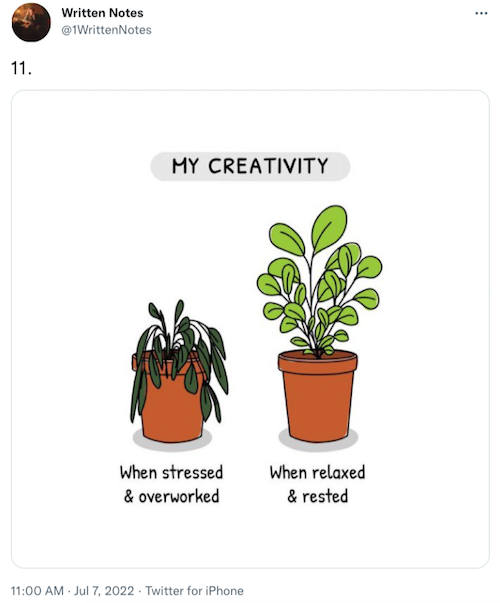
So, once you accept that success isn’t about the hours worked but the worth of what you’ve done in those hours, you have to pivot to understanding that more and more of your hours have to be given over to the downtime that allows you to create anything worthwhile. Recognizing the finitude of life is key to that attitude change. (Remember that when you get to the end of this post!)
So, what have we learned about healthy productivity?
- It’s not about spending all of your hours on work.
- To make the work you do accomplish valuable, you need to change your mindset and have more downtime.
- Downtime isn’t scrolling through TikTok or Netflix, but truly letting your brain rest and recover — through non-competitive exercise, better sleep, eschewing multitasking, increasing opportunities for a quiet mind, and asking yourself the essential questions about the life you’re currently living and how it compares to the one you truly want — as we discussed in Toxic Productivity Part 3: Get Off the To-Do List Hamster Wheel.
- We can use the same productivity tools designed to help us overcome procrastination and get more done to slow ourselves down to the speed of life. This includes embracing better and smaller (atomic) habits, using the Pareto Principle to focus on what’s truly worthy of being a priority, employing the Pomodoro Technique and block scheduling to focus our work time and ensure our break time.
— Liz Fosslien (@fosslien) June 23, 2022
What else can we do?
CONSIDER TECHNOLOGY’S ROLE
It’s easy to think that technology is essential to productivity. Look at how much more humanity accomplished after the Industrial Revolution vs. when we had an agrarian society. How much more could we accomplish with telephones than when we had to wait for the postal service or telegrams? Certainly we got much more accomplished once we added email to our resources, right? (cough, cough) And surely we’ve reached a pinnacle of productivity now that we have Slack and Asana?
Hopefully, you detected my sarcasm. Yes, technology yields vast improvements in our ability to communicate quickly (if not always clearly, as the multigenerational confusion over emoji and whether ending sentences with periods is an insult have proven), but all of these aspects of technology have led to the always-on misery we discussed at the beginning of the series. France gets it; most of Europe gets it. The US does not yet get it.
We have an inalienable right to disconnect, but it’s going to take all of us, together, to stand up and keep secure that right.
Communication technology is not the only problem.
Along with communication technology, these last few decades have seen a growth in productivity technology, from software and apps that help us brainstorm, assign ourselves (and others) tasks, and conquer our foibles and deficiencies in terms of procrastination, motivation, focus, capturing information, organizing our thoughts, collaborating on projects, and so on.
I am not a Luddite. I believe in the power of technology to make things easier, but sometimes we’re making the wrong things easier. Take collaboration. While Thomas Jefferson wrote the original draft of the Declaration of Independence, historians (including Pauline Maier in American Scripture: Making the Declaration of Independence) have shown how the handwritten edits suggested by the members of the Second Continental Congress became a complicated collaboration.
 In a document listing colonial grievances against the King George III, members of the Congress made Jefferson take out references to slavery and put in references to a Supreme Being (and fishing rights). The handwriting was that of Secretary Charles Thomson; he controlled the document’s additions, deletions, and revisions requested and/or demanded by the cacophony of voices representing 13 colonies.
In a document listing colonial grievances against the King George III, members of the Congress made Jefferson take out references to slavery and put in references to a Supreme Being (and fishing rights). The handwriting was that of Secretary Charles Thomson; he controlled the document’s additions, deletions, and revisions requested and/or demanded by the cacophony of voices representing 13 colonies.
Now imagine that same collaborative product in Microsoft Word’s Track Changes or Google Docs’ comment section. Now multiply the different voices and competing methods listed on this Wikipedia entry listing types of collaborative software. (I’ll wait while you scroll.) If you know how to be productive in one technology, you might still be flummoxed in another.
The number, variety, complexity, and interoperability (and lack thereof) of technology solutions can be overwhelming.
Have you ever heard about a new task app and wondered if it could be the solution to all of your troubles? Have you tried Todoist? Anydo? TeuxDeux? Remember the Milk? Things 3? Google Tasks? What about more complex productivity suites, like Basecamp? Trello? Clickup? Asana?
In case you were wondering if I’d suggest one app to rule them all, I’m afraid that’s not the case.
The truth is, the best productivity app is the one you’ll use. The one you’ll commit to learning, commit to using, and the one you won’t “cheat” on when another shiny app starts flirting.
The truth is, the best productivity app is the one you'll use. The one you'll commit to learning, commit to using, and the one you won't 'cheat' on when another shiny app starts flirting. Share on XUnfortunately, some productivity technology overwhelms even the most diligent users. This may be because the information we get out of our productivity technology is only as good as the information we put in, and we humans are already overwhelmed.
All of these apps, working at the speed of light (and life), can’t prioritize for us. We capture tasks with the click of a button, but we are so pressed for time (and productivity) that we fail to take the requisite moments to figure out what work has value and what is busywork.
So, are we supposed to get rid of technology altogether to combat toxic productivity?
Remember how I said I wasn’t a Luddite? Well, I’m not asking you to be one either. Chances are, if you work for a company that you don’t own, you’re stuck with some technology required by your workplace. But in the areas where you do have control over which types of technology you use, I often suggest that my clients put technology completely aside for a little while.
If you’ve got a task app or other tech that works well for you, stick with it. But if you feel beaten down and bruised by the very tech that’s supposed to keep your head above water, try slowing everything down.
- Go analog with your time displays. Wear an analog watch, or set your fancy Apple Watch or Fitbit to display time in an analog manner. Do the same with the display for the clock app on your phone. Seeing time as it ticks by will help you appreciate the finitude of time and feel more in tune with how much you can reasonably accomplish in an hour or a day. (You might want to brush up on Back-to-School Solutions for the Space-Time Continuum for more ideas.)

- Opt for paper over tech to learn key productivity skills. I’m a Certified Evernote Expert, so I realize all of the excellent benefits of collating your clipped websites, inbound emails, saved articles, etc., digitally, tagging them, and organizing them into notebooks. But when you’re overwhelmed, sometimes having your resources, your printed instructions, and other task-triggering action paperwork right in front of you, without need for WiFi or even electricity, can help you slow down and focus without the buzz of the digital world.
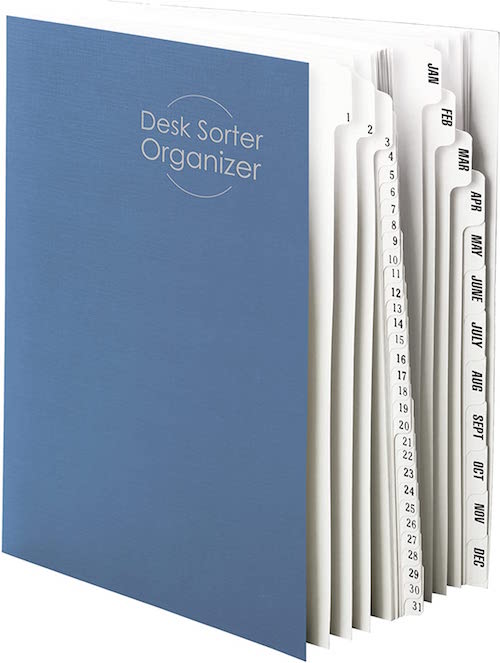
One of the many reasons I recommend tickler files for my overwhelmed clients is that learning the process of looking at task-triggering papers and making qualitative decisions (regarding priorities) and chronological decisions (regarding when you can reasonably accomplish specific tasks) is an essential skill for improving productivity in a healthy way. It’s the reason I wrote Tickle Yourself Organized.
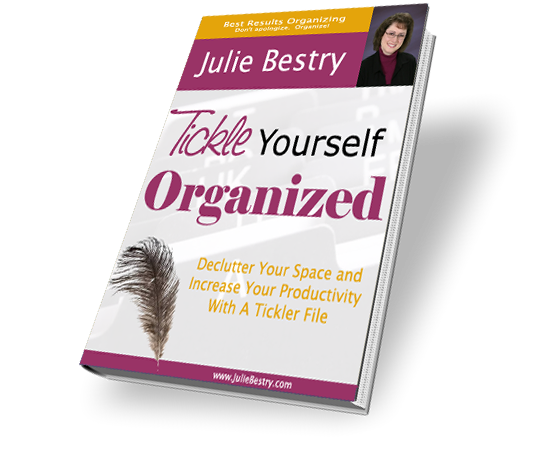
- Consider bullet journaling. I’ll be honest, bullet journaling stresses me out. I understand that it’s not necessary to embrace the fancy, artistic designs some people use, but the very hands-on, tangible customization options overwhelm me, and the idea is to achieve healthy productivity by removing overwhelm. But I’m not you. Hundreds of thousands, perhaps millions, of people swear by bullet journaling for tracking tasks and other information. They can’t all be wrong.
PULL IT ALL TOGETHER AND HALT A HUNGRY GHOST
Hopefully, over this past month, you’ve come to recognize that not only are you not a robot, but that it’s unacceptable for anyone — your company, your clients, your mother-in-law, or you — to expect non-stop labor from you.
If machines don’t operate at 100%, why do we expect so much from ourselves?
— Junhan (@junhanchin) May 24, 2022
You’re a living, breathing human being. But you may have a ghost in your machine.
In Brad Stulberg‘s recent post The Constant Restlessness You Feel Has a Name, he describes how many of us experience a constant grind he calls “heroic individualism.”
Heroic individualism says that you will never have enough, be enough, or do enough. It is an endless gauntlet of more. While it may lead to decent short-term performance, long-term, it is a recipe for disaster. This is because long-term fulfillment depends upon things that are inherently inefficient and unproductive, at least on acute timescales.
Sound familiar?
When you look at the ten symptoms of heroic individualism that Stulberg lays out, some of it bears a striking resemblance to toxic productivity and Anna Codreo-Rado‘s perception of productivity dysmorphia, such as:
- Low-level anxiety and a sensation of always being rushed or in a hurry — if not physically, then mentally.
- Not always wanting to be on, but struggling to turn it off and not feeling good when you do.
- Feeling too busy, but also restless when you have open time and space.
- Successful by conventional standards, yet feeling like you’re never enough.
Stulberg’s describes the Buddhist concept of the hungry ghost:
The hungry ghost has an endless stomach. He keeps on eating, stuffing himself sick, but he never feels full. It’s a severe disorder.
The modern world that so many of us inhabit depends on the creation of hungry ghosts. But you, me, all of us can choose to opt out of this game. We don’t have to become hungry ghosts. We simply need to step back and reflect upon what it is that we actually want. Simple, sure. But not necessarily easy.
To combat this hungry ghost, this toxic productivity, this productivity dysmorphia, Stulberg recommends the concept of groundnessness.
His book, The Practice of Groundedness: A Transformative Path to Success That Feeds—Not Crushes—Your Soul, combines research from psychology, neuroscience, and sociology (as we looked at in the first three posts in this Toxic Productivity series), as well as religious and philosophical teachings from Buddhism, Taoism, and our old friend-of-Seneca, Stoicism.



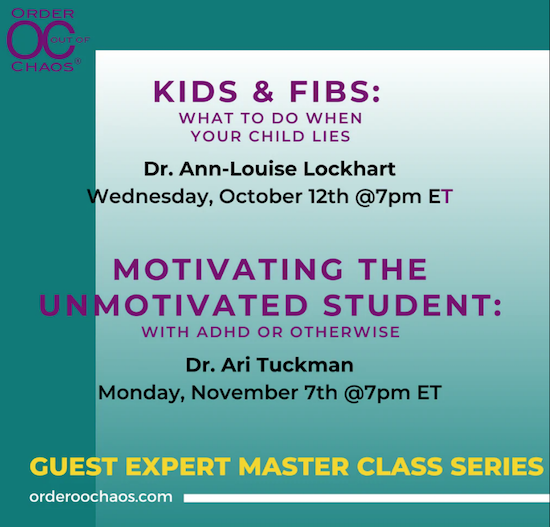





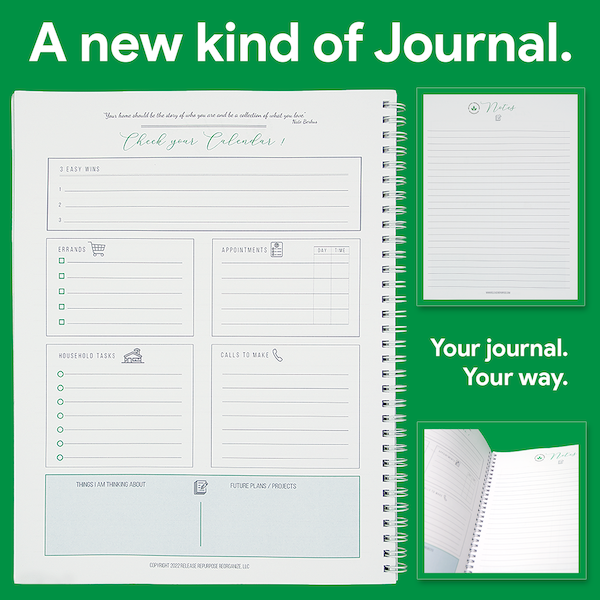




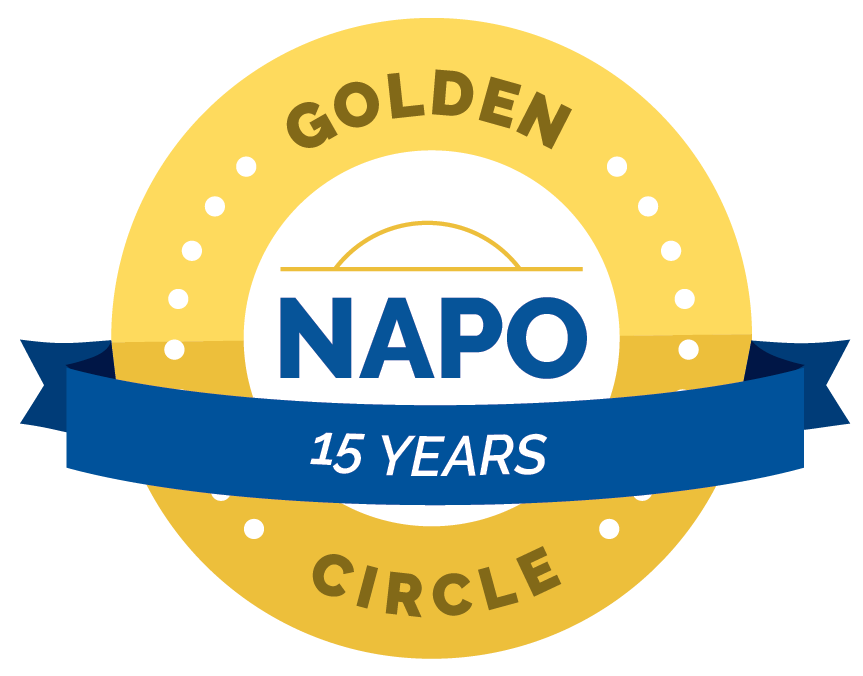


Follow Me